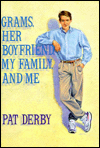

 |

|

The average rating for Grams, her boyfriend, my family, and me based on 2 reviews is 3.5 stars.
Review # 1 was written on 2015-05-14 00:00:00 Ramona Sledge Ramona SledgeOne of my favorites, probably because I was the kid's age when I first read it, so it spoke to me. |
Review # 2 was written on 2014-11-04 00:00:00 Ashley Gautney Ashley GautneyHorn Book (Spring, 2002) The little girl from Good as Goldie returns, and this time she's angry as only a big sister can be when her baby brother slobbers on her favorite doll. In expressive illustrations, Goldie's anger bursts right off the page. During a time-out, she fumes but then recalls Nicholas's good side. The book simply yet vividly portrays sibling anger, frustration, and (realistically short-lived) contrition. Publishers Weekly (July 2, 2001) The big sister from Good as Goldie pitches a fit when she sees her brother clutching her favorite doll in Goldie Is Mad by Margie Palatini. At first Goldie wants him to disappear, but repetitive, gradually softening phrases show how she mellows, using her doll as a buffer. This recap of an everyday squabble models a logical (though not guaranteed) way out of a tantrum. ( July) Copyright 2001 Cahners Business Information. School Library Journal (July 1, 2001) PreS-K-Goldie expresses anger with flailing arms, flaring eyes, and a constricted or screaming mouth. She is angry because her baby brother has sucked the hair of Veronica, her junior fashion doll. When the preschooler states, "I hate Nicholas," she and Veronica get a time-out "to think and be sorry." Initially, "we don't think we are sorry. We think we still hate Nicholas!" Goldie imagines the baby disappearing, then regrets the loss of his post-bathtime smell and hugs. Just after she and Veronica make a contrite apology to an unseen, unheard authority figure, Nicholas uses the doll's arm as a chew toy, leaving the child to wonder once again how she feels about her younger sibling. Goldie's simply stated monologue conveys her conflict with her brother and the range of resulting feelings. As in Good as Goldie (Hyperion, 2000), Palatini uses ink-pen and watercolor cartoon drawings in bold, primary colors to portray her protagonist's emotions. When Goldie is angry, her image fills most of a page; when her feelings soften, her image shrinks in size. The book will work for storytimes and laptimes, to help children identify feelings, come to terms with a younger sibling, or identify the complexities of any relationship.-Laura Scott, Baldwin Public Library, Birmingham, MI Copyright 2001 Cahners Business Information. |
CAN'T FIND WHAT YOU'RE LOOKING FOR? CLICK HERE!!!